The best dark sky national parks for photography include Joshua Tree, Death Valley, Big Bend, Bryce Canyon, and Arches. Visit during new moon phases (especially April-September) for ideal visibility of the Milky Way and celestial objects. Bring essential gear: manual camera, sturdy tripod, wide-angle lens, remote shutter, and extra batteries. Allow 20 minutes for your eyes to adjust to darkness. The stunning compositions you’ll capture where natural landmarks frame cosmic wonders will transform your portfolio forever.
Dark Sky Photo Spots: National Parks After Sunset
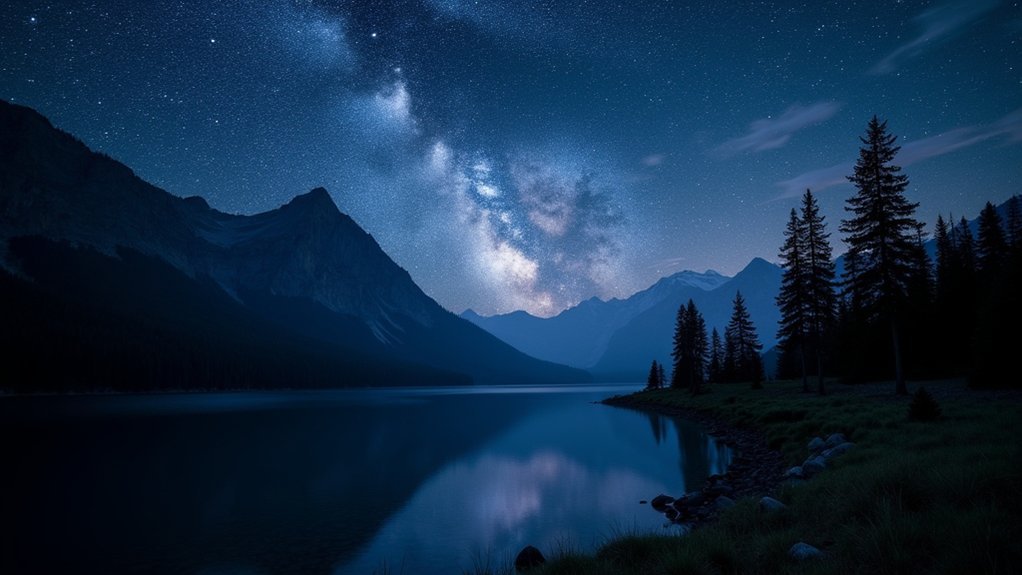
While urbanites often miss the breathtaking spectacle of truly dark skies, America’s national parks offer photographers unparalleled access to celestial wonders.
Joshua Tree, designated as an official Dark Sky Place, provides iconic rock formations that create dramatic silhouettes against the star-filled canvas.
Towering Joshua trees punctuate the darkness, striking silhouettes against a glittering celestial tapestry seldom seen by city dwellers.
You’ll find exceptional astrophotography conditions at Death Valley and Big Bend during new moon phases when night skies appear at their darkest.
For Milky Way shots, head to Arches National Park’s Balanced Rock or Panorama Point, where galactic views seem close enough to touch.
Bryce Canyon’s 8,000-foot elevation offers a unique advantage – on clear nights, you might even capture the Andromeda Galaxy.
Meanwhile, Glacier and Capitol Reef deliver spectacular viewing on moonless nights, with minimal light pollution revealing constellations in remarkable detail.
Top Dark Sky Certified Parks for Milky Way Photography
You’ll find breathtaking Milky Way shots in America’s remote Western treasures like Arches and Big Bend, where minimal light pollution creates ideal conditions for desert night photography.
Utah’s high-elevation parks, including Bryce Canyon, offer exceptional clarity for capturing the galaxy’s intricate details against dramatic landscapes.
These mountainous stargazing havens, from Death Valley’s expansive vistas to Zion’s newly certified dark skies, provide year-round opportunities to photograph celestial wonders above distinctive terrain formations.
Remote Western Treasures
The American West houses nature’s most spectacular astronomical theaters, with five premier Dark Sky Parks beckoning astrophotographers to capture the Milky Way in its full glory.
In Utah, Arches National Park’s Balanced Rock and Panorama Point frame celestial wonders, while nearby Bryce Canyon’s 8,000-foot elevation brings the Andromeda Galaxy within sight.
Canyonlands offers 24/7 access and ranger-led stargazing programs amid its vast desert landscapes.
Venture to Texas, where Big Bend boasts some of the continent’s darkest skies, making it ideal for unobstructed cosmic photography.
For accessible stargazing, Joshua Tree’s minimal light pollution creates perfect conditions for night sky enthusiasts.
Each park provides unique foreground elements—from twisted trees to dramatic arches—that’ll transform your Milky Way shots from ordinary to extraordinary.
Desert Night Photography
Five certified Dark Sky Parks stand out as premier destinations for capturing the Milky Way’s celestial drama against striking desert backdrops. Each location offers unique opportunities to photograph our galaxy above spectacular landscapes.
| Park Name | Best Feature |
|---|---|
| Death Valley National Park | Lowest light pollution in California with expansive vistas |
| Big Bend National Park | Stunning views over Chisos Basin; one of continental USA’s darkest spots |
| Joshua Tree National Park | Desert silhouettes create dramatic foreground elements |
| Bryce Canyon National Park | High elevation viewing from Bryce Point with hoodoo formations |
| Arches National Park | Frame the galactic core behind iconic formations like Delicate Arch |
You’ll find summer months most advantageous for capturing the galactic core, particularly in Arches. The minimal light interference at these locations reveals astronomical details often invisible in urban environments.
Mountainous Stargazing Havens
Majestic mountains offer a dramatic dimension to night sky photography that complements the desert locations previously explored.
Glacier National Park in Montana stands out as part of the first International Dark-Sky Park spanning a border, where mountainous silhouettes frame the Milky Way against pristine dark skies.
At Bryce Canyon National Park, you’ll find exceptional stargazing at 8,000 feet elevation. This Utah Dark Sky Park allows photographers to capture not just the Milky Way but even the Andromeda Galaxy on clear nights.
For dramatic foregrounds, position your camera near iconic Delicate Arch in Arches National Park, another Dark Sky Park where minimal light pollution enhances celestial visibility.
These National Parks combine breathtaking mountain landscapes with protected dark skies, creating perfect conditions for capturing the cosmos in all its glory.
Essential Camera Gear for National Park Night Shooting
Capturing the cosmos requires specialized equipment when you’re venturing into national parks after dark. A manual camera is non-negotiable—you’ll need complete control over exposure time and ISO settings to properly photograph stars against the night sky.
Mount your camera on a sturdy tripod to eliminate blur during those essential long exposure shots. Even the slightest vibration can ruin an otherwise perfect image of celestial objects.
Stability isn’t optional—it’s what separates cosmic masterpieces from blurry disappointments in astrophotography.
Pair this setup with a wide-angle lens (14-24mm) to encompass vast starry landscapes. Don’t forget a remote shutter release to trigger your camera without touching it, further reducing camera shake.
And since nighttime temperatures can quickly drain batteries, especially during winter shoots, pack extras to guarantee you’re not left in the dark just as the Milky Way appears in all its glory.
Planning Your Visit: Best Times for Dark Sky Photography
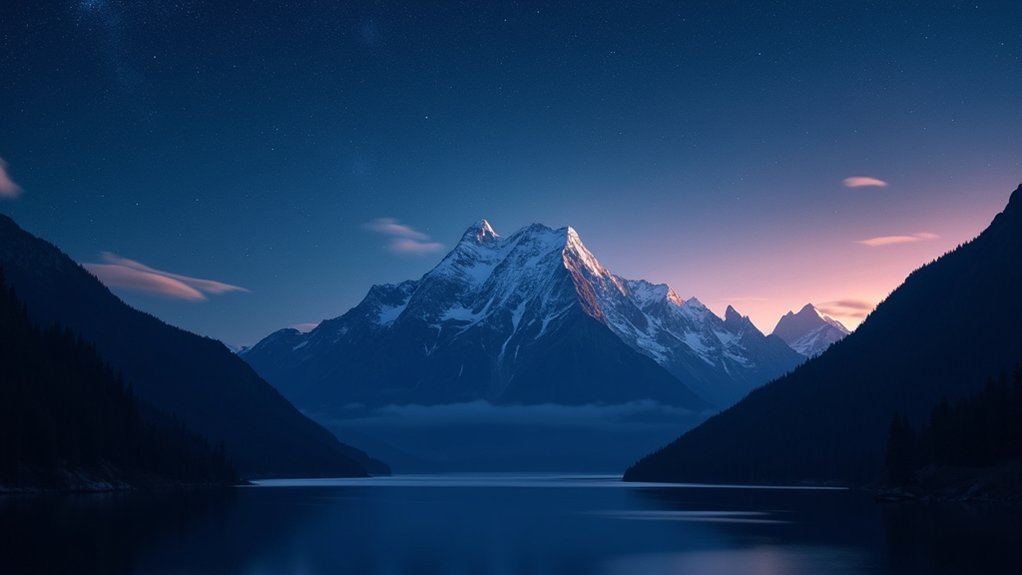
To capture breathtaking dark sky photographs, you’ll need to time your visit around the new moon when celestial objects shine brightest against the inky canvas.
Factor in seasonal events like meteor showers, the Milky Way’s prime visibility window (April through September), and the Aurora Borealis displays in northern parks during fall and winter.
For peak clarity, schedule your shoots during September evenings when conditions often provide exceptional transparency with minimal atmospheric disturbance and comfortable temperatures for lengthy exposure sessions.
Moon Cycle Considerations
The moon’s phase dramatically impacts your dark sky photography success. For the most breathtaking celestial shots, you’ll want to align your visit with the new moon phase when the sky is at its darkest.
During September, you’ll find excellent stargazing opportunities, but be aware that the full moon on 9/16 will wash out fainter stars and the Milky Way.
For peak star visibility during your dark night photography adventure:
- Schedule your trip during a new moon when the sky is darkest
- Allow a full 20 minutes for your eyes to properly adjust to darkness
- Check weather forecasts in advance to guarantee clear, cloudless conditions
Remember that moonless nights provide the ideal canvas for capturing the universe’s most stunning features.
Seasonal Celestial Events
Beyond moon phases, specific times of year offer spectacular celestial displays that can transform your astrophotography from ordinary to extraordinary. Mark your calendar for the Perseid meteor shower in August and the Geminids in December, when you’ll capture stunning shooting stars against dark backdrops.
September evenings provide ideal conditions for night sky photography with clear skies and comfortable temperatures. You’ll find these mild conditions perfect for longer sessions, allowing you to capture intricate celestial features in their full glory.
Remember to give your eyes about 20 minutes to adjust to darkness before shooting. This patience pays off when photographing faint details that might otherwise be missed.
Always use a tripod for those essential long exposures – steady equipment makes the difference between blurry skies and sharp, detailed captures.
Peak Clarity Windows
Planning your dark sky photography expedition requires careful attention to peak clarity windows—those perfect moments when stars shine brightest against truly dark skies.
September evenings offer exceptional conditions for capturing the celestial canvas, especially at the best places where light pollution is minimal.
Time your visit during these ideal windows:
- New moon phases – When moonless nights create perfect dark conditions for photographing fainter celestial objects
- Post-sunset shift – The magical 30-60 minutes after sunset when twilight colors fade and stars begin emerging
- Twenty minutes after dark – When your eyes have fully adjusted to darkness, revealing details invisible to newcomers
Many national parks host scheduled star party events during peak clarity windows, providing guided viewing with experienced astronomers and specialized equipment.
Light Pollution Maps: Finding the Clearest Night Skies
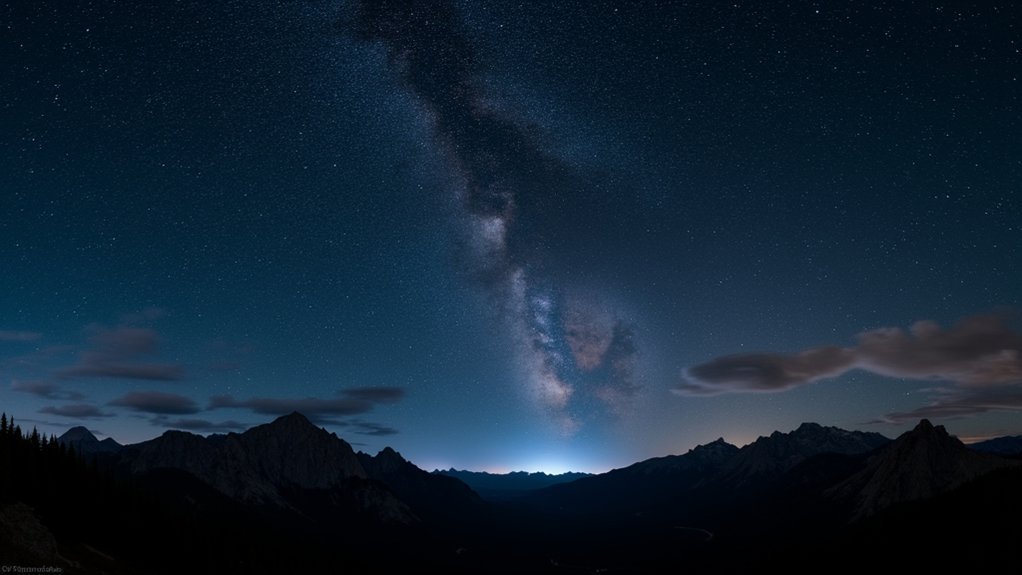
When searching for perfect stargazing locations, light pollution maps serve as essential navigation tools for astronomy enthusiasts and photographers alike.
The Bortle Scale, ranking skies from 1-9, helps you quickly identify prime viewing spots away from artificial light interference.
For ideal results, consult real-time light pollution data through mobile apps before planning your trip.
International Dark Sky Parks offer guaranteed exceptional viewing conditions, with official designation indicating minimal light pollution.
These locations provide your best chance of capturing stunning Milky Way photographs and observing celestial details often washed out in urban areas.
The International Dark-Sky Association’s curated list of locations can guide you to these astronomical havens.
Plan your visits during new moon phases when venturing to these dark sky sanctuaries for truly spectacular stargazing experiences.
Desert Southwest Parks: Dramatic Landscape Silhouettes
The Desert Southwest’s national parks stand as premier destinations for astrophotographers seeking the perfect combination of dark skies and striking foregrounds.
These Dark Sky-designated havens offer unparalleled opportunities to capture the cosmos above dramatic landscapes.
You’ll find exceptional Milky Way viewing at:
- Death Valley and Arches National Parks – Their distinctive rock formations create compelling silhouettes against star-filled backdrops, especially during moonless nights.
- Joshua Tree National Park – The iconic trees provide otherworldly foreground elements that contrast beautifully with cosmic displays.
- Bryce Canyon and Canyonlands – High elevations enhance celestial visibility, while locations like Island in the Sky frame the stars with dramatic canyons and mesas.
Visit during new moon phases for the darkest skies and most vivid celestial photography opportunities.
Mountain and Canyon Compositions for Star Trail Images
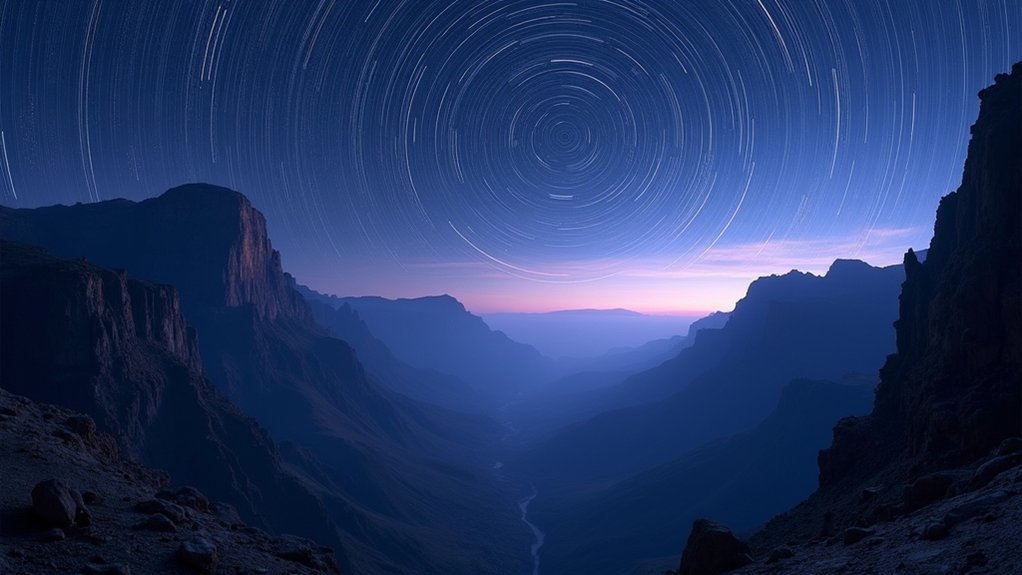
Dramatic mountain silhouettes and deep canyon walls create perfect natural frames for capturing mesmerizing star trail photography.
You’ll find that positioning your camera to utilize the natural contours of parks like Arches National Park adds impressive depth to your nighttime images.
For the most striking compositions, align iconic landmarks such as Delicate Arch or Balanced Rock with the arching Milky Way above.
Face north toward the North Star in dark sky parks like Bryce Canyon, where unobstructed views allow you to capture complete circular star trails.
Don’t overlook reflective surfaces in canyon parks—still water bodies can double your star trails’ visual impact on calm, clear nights.
Long exposure settings work best in locations like Big Bend National Park, where minimal light pollution reveals the night sky’s true brilliance.
Coastal Parks: Capturing Stars Over Water
Unlike inland locations, coastal dark sky parks offer photographers the unique advantage of capturing stellar reflections across vast water surfaces, doubling the visual impact of your nighttime compositions.
These destinations provide exceptional opportunities for night sky photography with minimal light pollution.
Consider these prime coastal stargazing locations:
- Cape Lookout National Seashore – Capture stunning reflections of stars on ocean waters for dramatic mirror effects in your compositions.
- Big Cypress National Preserve – Frame the night sky with silhouetted cypress trees rising from serene wetlands.
- Acadia National Park’s Cadillac Mountain – Photograph the Milky Way arching over the Atlantic Ocean during clear summer nights.
Cape May Point State Park offers unobstructed horizons perfect for wide-angle shots, while coastal parks’ reduced light pollution creates ideal conditions for long-exposure photography during meteor showers.
Weather Considerations for Night Sky Photography
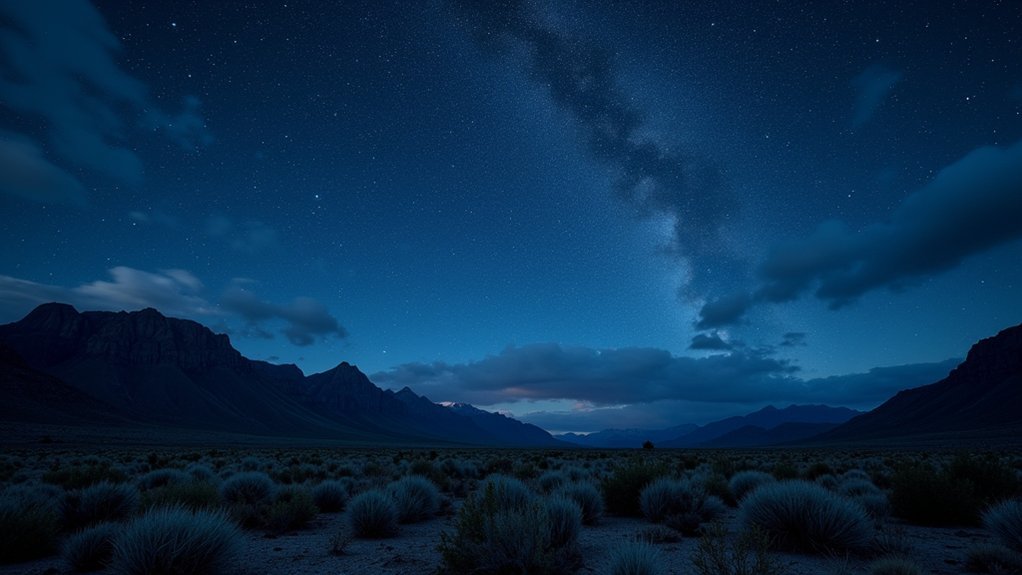
While coastal locations offer spectacular backdrops for astrophotography, success in capturing pristine night sky images ultimately depends on atmospheric conditions. Clear skies are non-negotiable—plan your shoots during moonless nights and check local weather forecasts for cloud cover in advance.
The perfect coastline means nothing without clear skies—atmospheric conditions make or break your astrophotography session.
Weather conditions affect visibility in significant ways. Lower humidity typically provides better clarity for night sky photography, while wind can ruin long exposures by causing camera shake. Combat this with a sturdy tripod and windbreaks when necessary.
Don’t forget that cold temperatures drain batteries quickly. Keep spares warm in your pockets until needed.
Monitor weather apps constantly throughout your session, as conditions can change rapidly. Being prepared for atmospheric variables will dramatically improve your chances of capturing those awe-inspiring celestial scenes.
Frequently Asked Questions
Which National Park Has the Darkest Skies?
Big Bend National Park in Texas has the darkest skies in the continental U.S. You’ll see thousands of stars and the Milky Way clearly due to its remote location and minimal light pollution.
Where Is the Best Place in the US to See the Night Sky?
You’ll find the best U.S. night sky at Big Bend National Park in Texas. With exceptionally dark skies, you can see over 2,000 stars on clear nights—an unparalleled stargazing experience you shouldn’t miss.
What US State Has the Most Dark Sky Parks?
Arizona has the most Dark Sky Parks in the U.S. You’ll find several designated locations there, including Saguaro National Park and Grand Canyon National Park, where you can experience exceptional stargazing opportunities.
Can You Visit Death Valley at Night?
Yes, you can visit Death Valley at night. It’s open 24/7 year-round. You’ll enjoy some of America’s darkest skies at locations like Mesquite Flat Sand Dunes and Badwater Basin. Don’t forget warm clothes!
In Summary
You’ll discover that national parks at night hold magic beyond daytime vistas. Whether you’re capturing the Milky Way arching over desert formations or star trails circling mountain peaks, these dark sanctuaries offer unparalleled photographic opportunities. Pack your gear thoughtfully, time your visit strategically, and respect park regulations. The memories you’ll create under pristine night skies will inspire you long after your adventure ends.

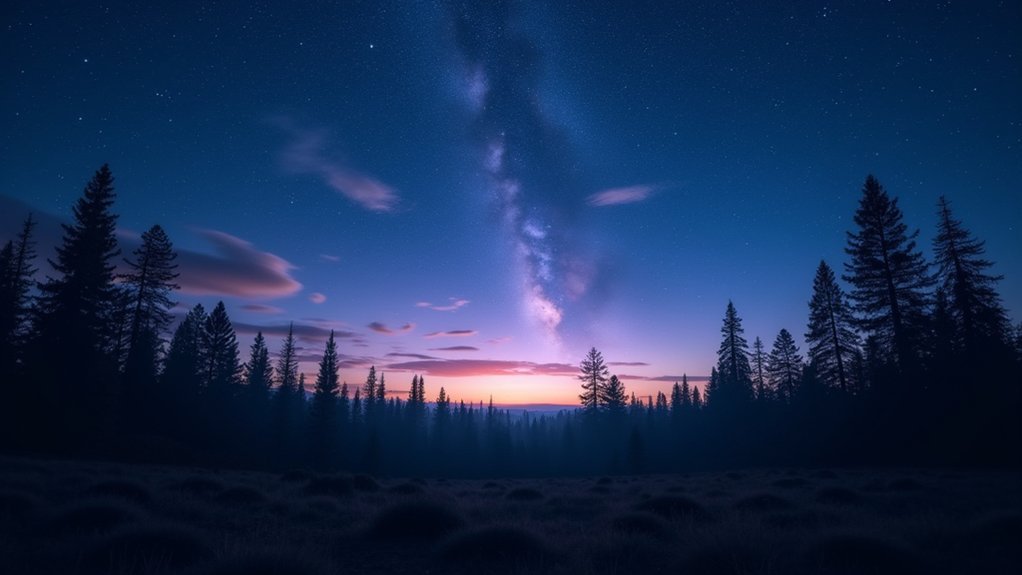



Leave a Reply